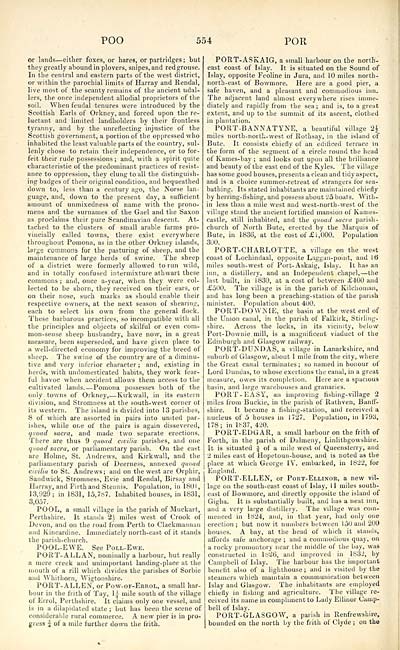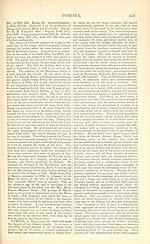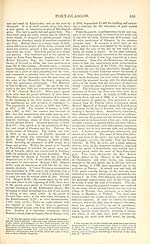Topographical, statistical, and historical gazetteer of Scotland > Volume 2
(570) Page 554
Download files
Complete book:
Individual page:
Thumbnail gallery: Grid view | List view

POO
554
POR
or lands — either foxes, or hares, or partridges ; but
they greatly abound in plovers, snipes, and red grouse.
In the central and eastern parts of the west district,
or within the parochial limits of Harray and Rendal,
live most of the scanty remains of the ancient udal-
lers, the once independent allodial proprietors of the
soil. When feudal tenures were introduced by the
Scottish Earls of Orkney, and forced upon the re-
luctant and limited landholders by their frontless
tyranny, and by the unreflecting injustice of the
Scottish government, a portion of the oppressed who
inhabited the least valuable parts of the country, sul-
lenly chose to retain their independence, or to for-
feit their rude possessions; and, with a spirit quite
characteristic of the predominant practices of resist-
ance to oppression, they clung to all the distinguish-
ing badges of their original condition, and bequeathed
down to, less than a century ago, the Norse lan-
guage, and, down to the present day, a sufficient
amount of unmixedness of name with the prono-
mens and the surnames of the Gael and the Saxon
as proclaims their pure Scandinavian descent. At-
tached to the clusters of small arable farms pro-
vincially called towns, there exist everywhere
throughout Pomona, as in the other Orkney islands,
large commons for the pasturing of sheep, and the
maintenance of large herds of swine. The sheep
of a district were formerly allowed to run wild,
and in totally confused intermixture athwart these
commons ; and, once a-year, when they were col-
lected to be shorn, they received on their ears, or
on their nose, such marks as should enable their
respective owners, at the next season of shearing,
each to select bis own from the general flock.
These barbarous practices, so incompatible with all
the principles and objects of skilful or even com-
mon-sense sheep husbandry, have now, in a great
measure, been superseded, and have given place to
a well-directed economy for improving the breed of
sheep. The swine of the country are of a diminu-
tive and very inferior character ; and, existing in
herds, with undomesticated habits, they work fear-
ful havoc when accident allows them access to the
cultivated lands. — Pomona possesses both of the
only towns of Orkney, — Kirkwall, in its eastern
division, and Stromness at the south-west corner ot
its western. The island is divided into 13 parishes,
8 of which are assorted in pairs into united par-
ishes, while one of the pairs is again dissevered,
quoad sacra, and made two separate erections.
There are thus 9 quoad civdia parishes, and one
quoad sacra, or parliamentary parish. On the east
are Holme, St. Andrews, and Kirkwall, and the
parliamentary parish of Deemess, annexed quoad
civilia to St. Andrews; and on the west are Orphir,
Sandwick, Stromness, Evie and Rendal, Birsay and
Harray, and Firth and Stennis. Population, in 1801,
13,929; in 1831, 15,787. Inhabited houses, in 1831,
3,057.
POOL, a small village in the parish of Muckart,
Perthshire. It stands 2i miles west of Crook of
Devon, and on the road from Perth to Clackmannan
and Kincardine. Immediately north-east of it stands
the parish-church.
POOL-EWE. See Poll-Ewe.
PORT-ALLAN, nominally a harbour, but really
a mere creek and unimportant landing-place at the
mouth of a rill which divides the parishes of Sorbie
and Whithorn, Wigtonshire.
PORT-ALLEN, or Pow-of-Errol, a small har-
bour in the frith of Tay, \~ mile south of the village
of Errol, Perthshire. It claims only one vessel, and
is in a dilapidated state ; but has been the scene of
considerable rural commerce. A new pier is in pro-
gress ^ of a mile further down the frith.
PORT-ASKAIG, a small harbour on the north-
east coast of Islay. It is situated on the Sound of
Islay, opposite Feoline in Jura, and 10 miles north-
north-east of Bowmore. Here are a good pier, a
safe haven, and a pleasant and commodious inn.
The adjacent land almost everywhere rises imme-
diately and rapidly from the sea ; and is, to a great
extent, and up to the summit of its ascent, clothed
in plantation.
PORT-BANNATYNE, a beautiful village 2£
miles north-north-west of Rothsay, in the island of
Bute. It consists chiefly of an edificed terrace in
the form of the segment of a circle round the head
of Kames-bay ; and looks out upon all the brilliance
and beauty of the east end of the Kyles. The village
has some good houses, presents a clean and tidy aspect,
and is a choice summer-retreat of strangers for sea-
bathing. Its stated inhabitants are maintained chiefly
by herring-fishing, and possess about 25 boats. With-
in less than a mile west and west-north-west of the
village stand the ancient fortified mansion of Kames-
castle, still inhabited, and the quoad sacra parish -
church of North Bute, erected by the Marquis of
Bute, in 183G, at the cost of £ 1 ,000. Population
3(J0.
PORT-CHARLOTTE, a village on the west
coast of Lochindaal, opposite Laggan-point, and 16
miles south-west of Port-Askaig, Islay. It has an
inn, a distillery, and an Independent chapel, — the
last built, in 1830, at a cost of between £400 and
£500. The village is in the parish of Kilchoman,
and has long been a preaching-station of the parish
minister. Population about 400.
PORT-DOWNIE, the basin at the west end of
the Union canal, in the parish of Falkirk, Stirling-
shire. Across the locks, in its vicinity, below
Port-Downie mill, is a magnificent viaduct of the
Edinburgh and Glasgow railway.
PORT-DUN DAS, a village in Lanarkshire, and
suburb of Glasgow, about 1 mile from the city, where
the Great canal terminates ; so named in honour of
Lord L>undas, to whose exertions the canal, in a great
measure, owes its completion. Here are a spacious
basin, and large warehouses and granaries.
PORT -EASY, an improving fishing-village 2
miles from Buckie, in the parish of Rathven, Banff-
shire. It became a fishing-station, and received a
nucleus of 5 houses in 1727. Population, in 1793,
178; in 1837, 420.
PORT-EDGAR, a small harbour on the frith of
Forth, in the parish of Dalmeny, Linlithgowshire.
It is situated J of a mile west of Queensterry, and
2 miles east of Hopetouu-house, and is noted as the
place at which George IV. embarked, in 1822, for
England.
PORT-ELLEN, or Port-Ellinor, a new vil-
lage on the south-east coast of Islay, 1 1 miles south-
east of Bowmore, and directly opposite the island of
Gigha. It is substantially built, and has a neat inn,
and a very large distillery. The village was com-
menced in 1824, and, in that year, had only one
erection; but now it numbers between 150 and 200
houses. A bay, at the head of which it stands,
affords safe anchorage ; and a commodious quay, on
a rocky promontory near the middle of the bay, was
constructed in 1826, and improved in 1832, by
Campbell of Islay. The harbour has the important
benefit also of a lighthouse ; and is visited by the
steamers which maintain a communication between
Islay and Glasgow. The inhabitants are employed
chiefly in fishing and agriculture. The village re-
ceived its name in compliment to Lady Ellinor Camp-
bell of Islay.
PORT-GLASGOW, a parish in Renfrewshire,
bounded on the north by the frith of Clyde ; on the
554
POR
or lands — either foxes, or hares, or partridges ; but
they greatly abound in plovers, snipes, and red grouse.
In the central and eastern parts of the west district,
or within the parochial limits of Harray and Rendal,
live most of the scanty remains of the ancient udal-
lers, the once independent allodial proprietors of the
soil. When feudal tenures were introduced by the
Scottish Earls of Orkney, and forced upon the re-
luctant and limited landholders by their frontless
tyranny, and by the unreflecting injustice of the
Scottish government, a portion of the oppressed who
inhabited the least valuable parts of the country, sul-
lenly chose to retain their independence, or to for-
feit their rude possessions; and, with a spirit quite
characteristic of the predominant practices of resist-
ance to oppression, they clung to all the distinguish-
ing badges of their original condition, and bequeathed
down to, less than a century ago, the Norse lan-
guage, and, down to the present day, a sufficient
amount of unmixedness of name with the prono-
mens and the surnames of the Gael and the Saxon
as proclaims their pure Scandinavian descent. At-
tached to the clusters of small arable farms pro-
vincially called towns, there exist everywhere
throughout Pomona, as in the other Orkney islands,
large commons for the pasturing of sheep, and the
maintenance of large herds of swine. The sheep
of a district were formerly allowed to run wild,
and in totally confused intermixture athwart these
commons ; and, once a-year, when they were col-
lected to be shorn, they received on their ears, or
on their nose, such marks as should enable their
respective owners, at the next season of shearing,
each to select bis own from the general flock.
These barbarous practices, so incompatible with all
the principles and objects of skilful or even com-
mon-sense sheep husbandry, have now, in a great
measure, been superseded, and have given place to
a well-directed economy for improving the breed of
sheep. The swine of the country are of a diminu-
tive and very inferior character ; and, existing in
herds, with undomesticated habits, they work fear-
ful havoc when accident allows them access to the
cultivated lands. — Pomona possesses both of the
only towns of Orkney, — Kirkwall, in its eastern
division, and Stromness at the south-west corner ot
its western. The island is divided into 13 parishes,
8 of which are assorted in pairs into united par-
ishes, while one of the pairs is again dissevered,
quoad sacra, and made two separate erections.
There are thus 9 quoad civdia parishes, and one
quoad sacra, or parliamentary parish. On the east
are Holme, St. Andrews, and Kirkwall, and the
parliamentary parish of Deemess, annexed quoad
civilia to St. Andrews; and on the west are Orphir,
Sandwick, Stromness, Evie and Rendal, Birsay and
Harray, and Firth and Stennis. Population, in 1801,
13,929; in 1831, 15,787. Inhabited houses, in 1831,
3,057.
POOL, a small village in the parish of Muckart,
Perthshire. It stands 2i miles west of Crook of
Devon, and on the road from Perth to Clackmannan
and Kincardine. Immediately north-east of it stands
the parish-church.
POOL-EWE. See Poll-Ewe.
PORT-ALLAN, nominally a harbour, but really
a mere creek and unimportant landing-place at the
mouth of a rill which divides the parishes of Sorbie
and Whithorn, Wigtonshire.
PORT-ALLEN, or Pow-of-Errol, a small har-
bour in the frith of Tay, \~ mile south of the village
of Errol, Perthshire. It claims only one vessel, and
is in a dilapidated state ; but has been the scene of
considerable rural commerce. A new pier is in pro-
gress ^ of a mile further down the frith.
PORT-ASKAIG, a small harbour on the north-
east coast of Islay. It is situated on the Sound of
Islay, opposite Feoline in Jura, and 10 miles north-
north-east of Bowmore. Here are a good pier, a
safe haven, and a pleasant and commodious inn.
The adjacent land almost everywhere rises imme-
diately and rapidly from the sea ; and is, to a great
extent, and up to the summit of its ascent, clothed
in plantation.
PORT-BANNATYNE, a beautiful village 2£
miles north-north-west of Rothsay, in the island of
Bute. It consists chiefly of an edificed terrace in
the form of the segment of a circle round the head
of Kames-bay ; and looks out upon all the brilliance
and beauty of the east end of the Kyles. The village
has some good houses, presents a clean and tidy aspect,
and is a choice summer-retreat of strangers for sea-
bathing. Its stated inhabitants are maintained chiefly
by herring-fishing, and possess about 25 boats. With-
in less than a mile west and west-north-west of the
village stand the ancient fortified mansion of Kames-
castle, still inhabited, and the quoad sacra parish -
church of North Bute, erected by the Marquis of
Bute, in 183G, at the cost of £ 1 ,000. Population
3(J0.
PORT-CHARLOTTE, a village on the west
coast of Lochindaal, opposite Laggan-point, and 16
miles south-west of Port-Askaig, Islay. It has an
inn, a distillery, and an Independent chapel, — the
last built, in 1830, at a cost of between £400 and
£500. The village is in the parish of Kilchoman,
and has long been a preaching-station of the parish
minister. Population about 400.
PORT-DOWNIE, the basin at the west end of
the Union canal, in the parish of Falkirk, Stirling-
shire. Across the locks, in its vicinity, below
Port-Downie mill, is a magnificent viaduct of the
Edinburgh and Glasgow railway.
PORT-DUN DAS, a village in Lanarkshire, and
suburb of Glasgow, about 1 mile from the city, where
the Great canal terminates ; so named in honour of
Lord L>undas, to whose exertions the canal, in a great
measure, owes its completion. Here are a spacious
basin, and large warehouses and granaries.
PORT -EASY, an improving fishing-village 2
miles from Buckie, in the parish of Rathven, Banff-
shire. It became a fishing-station, and received a
nucleus of 5 houses in 1727. Population, in 1793,
178; in 1837, 420.
PORT-EDGAR, a small harbour on the frith of
Forth, in the parish of Dalmeny, Linlithgowshire.
It is situated J of a mile west of Queensterry, and
2 miles east of Hopetouu-house, and is noted as the
place at which George IV. embarked, in 1822, for
England.
PORT-ELLEN, or Port-Ellinor, a new vil-
lage on the south-east coast of Islay, 1 1 miles south-
east of Bowmore, and directly opposite the island of
Gigha. It is substantially built, and has a neat inn,
and a very large distillery. The village was com-
menced in 1824, and, in that year, had only one
erection; but now it numbers between 150 and 200
houses. A bay, at the head of which it stands,
affords safe anchorage ; and a commodious quay, on
a rocky promontory near the middle of the bay, was
constructed in 1826, and improved in 1832, by
Campbell of Islay. The harbour has the important
benefit also of a lighthouse ; and is visited by the
steamers which maintain a communication between
Islay and Glasgow. The inhabitants are employed
chiefly in fishing and agriculture. The village re-
ceived its name in compliment to Lady Ellinor Camp-
bell of Islay.
PORT-GLASGOW, a parish in Renfrewshire,
bounded on the north by the frith of Clyde ; on the
Set display mode to: Large image | Transcription
Images and transcriptions on this page, including medium image downloads, may be used under the Creative Commons Attribution 4.0 International Licence unless otherwise stated. ![]()
| Gazetteers of Scotland, 1803-1901 > Topographical, statistical, and historical gazetteer of Scotland > Volume 2 > (570) Page 554 |
|---|
| Permanent URL | https://digital.nls.uk/97455430 |
|---|
| Description | Volume second: I-Z. |
|---|---|
| Shelfmark | Map Room Ref.2 |
| Attribution and copyright: |
|

